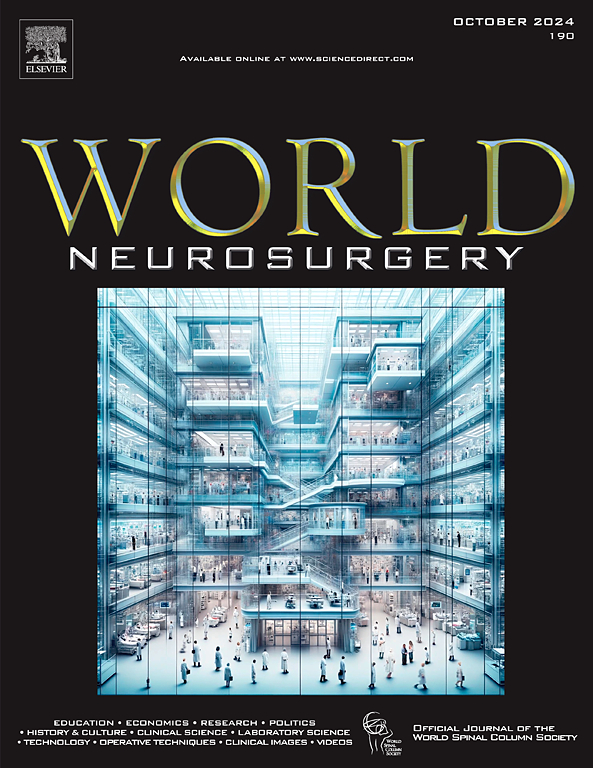Trends in the Management of Oligodendrogliomas: A Multinational and Multidisciplinary Survey Study
IF 1.9
4区 医学
Q3 CLINICAL NEUROLOGY
引用次数: 0
Abstract
Objective
Oligodendrogliomas present challenges in management despite their favorable prognosis. Optimal therapeutic strategies are not well-established. We aimed to characterize current practice patterns and identify areas of discordance in oligodendroglioma management.
Methods
A 20-question survey was distributed February-July 2023 to 4 professional neurosurgery/neuro-oncology societies to assess practices in oligodendroglioma management. The survey collected data on demographics, diagnostic practices, and treatment decisions. Data analysis was performed using chi-square/Fisher's exact tests.
Results
Sixty-three physicians responded, representing 12 countries. Diagnostic practices were consistent among respondents. However, variations in management recommendations were observed. Providers were divided between rarely (36.5%), sometimes (25.4%), and often (30.2%) using temozolomide (TMZ) as sole chemotherapy for patients with newly diagnosed oligodendroglioma. For patients with subtotal resection of grade 2 oligodendroglioma, 33.3% of providers recommended upfront radiation/chemotherapy, 27.0% recommended observation, and the remaining 39.7% were divided among options including surgery, chemotherapy, and clinical trials. European providers more frequently recommended surgery (33.3% vs. 0.0%), whereas radiation/chemotherapy (35.7% vs. 26.7%) or observation (31.0% vs. 13.3%) was more commonly recommended by U.S./Canada providers (P = 0.009). Providers also disagreed on adjuvant therapy for grade 3 oligodendroglioma. 47.6% recommended radiation/procarbazine, lomustine, and vincristine, and 33.3% recommended radiation/TMZ. This decision varied by region, with European providers more frequently recommending radiation/procarbazine, lomustine, and vincristine (86.7% vs. 33.3%) and U.S./Canadian providers more frequently recommending radiation/TMZ (40.5% vs. 6.7%; P = 0.004).
Conclusions
This study underscores the complexity of oligodendroglioma management and the importance of ongoing research to refine therapeutic strategies. Further studies, especially with the introduction of isocitrate dehydrogenase inhibitors in practice, are warranted to track practice patterns and reassess recommendations.
求助全文
约1分钟内获得全文
求助全文
来源期刊

World neurosurgery
CLINICAL NEUROLOGY-SURGERY
CiteScore
3.90
自引率
15.00%
发文量
1765
审稿时长
47 days
期刊介绍:
World Neurosurgery has an open access mirror journal World Neurosurgery: X, sharing the same aims and scope, editorial team, submission system and rigorous peer review.
The journal''s mission is to:
-To provide a first-class international forum and a 2-way conduit for dialogue that is relevant to neurosurgeons and providers who care for neurosurgery patients. The categories of the exchanged information include clinical and basic science, as well as global information that provide social, political, educational, economic, cultural or societal insights and knowledge that are of significance and relevance to worldwide neurosurgery patient care.
-To act as a primary intellectual catalyst for the stimulation of creativity, the creation of new knowledge, and the enhancement of quality neurosurgical care worldwide.
-To provide a forum for communication that enriches the lives of all neurosurgeons and their colleagues; and, in so doing, enriches the lives of their patients.
Topics to be addressed in World Neurosurgery include: EDUCATION, ECONOMICS, RESEARCH, POLITICS, HISTORY, CULTURE, CLINICAL SCIENCE, LABORATORY SCIENCE, TECHNOLOGY, OPERATIVE TECHNIQUES, CLINICAL IMAGES, VIDEOS
 求助内容:
求助内容: 应助结果提醒方式:
应助结果提醒方式:


